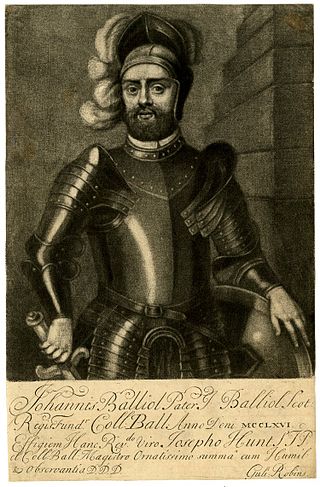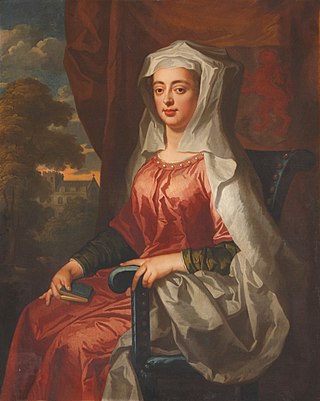Related Research Articles

Causantín mac Áeda was an early King of Scotland, known then by the Gaelic name Alba. The Kingdom of Alba, a name which first appears in Constantine's lifetime, was situated in modern-day Northern Scotland.

The Declaration of Arbroath is the name usually given to a letter, dated 6 April 1320 at Arbroath, written by Scottish barons and addressed to Pope John XXII. It constituted King Robert I's response to his excommunication for disobeying the pope's demand in 1317 for a truce in the First War of Scottish Independence. The letter asserted the antiquity of the independence of the Kingdom of Scotland, denouncing English attempts to subjugate it.
Malcolm III was King of Scotland from 1058 to 1093. He was later nicknamed "Canmore". Malcolm's long reign of 35 years preceded the beginning of the Scoto-Norman age. Henry I of England and Eustace III of Boulogne were his sons-in-law, making him the maternal grandfather of Empress Matilda, William Adelin and Matilda of Boulogne. All three of them were prominent in English politics during the 12th century.

The House of Balliol was a noble family originating from the village of Bailleul in Picardy. They held estates in England, granted during the reign of King William Rufus. Through marriage, they had claims to the Throne of Scotland. One member of the family, John Balliol, was named King of Scotland after the disputed succession following extinction of the Dunkeld line. John was deposed, leading to the First War of Scottish Independence. His son, Edward Balliol, also briefly controlled the Scottish throne during the Second War of Scottish Independence. Edward had no issue, and the direct line went extinct with him.

John de Balliol was an English nobleman, belonging to the House of Balliol. Balliol College, in Oxford, is named after him.
Alan of Galloway was a leading thirteenth-century Scottish magnate. As the hereditary Lord of Galloway and Constable of Scotland, he was one of the most influential men in the Kingdom of Scotland and Irish Sea zone.
Lochlann of Galloway, also known as Lochlan mac Uchtred and by his French name Roland fitz Uhtred, was the son and successor of Uchtred, Lord of Galloway as the "Lord" or "sub-king" of eastern Galloway.

Donnchadh was a Gall-Gaidhil prince and Scottish magnate in what is now south-western Scotland, whose career stretched from the last quarter of the 12th century until his death in 1250. His father, Gille-Brighde of Galloway, and his uncle, Uhtred of Galloway, were the two rival sons of Fergus, Prince or Lord of Galloway. As a result of Gille-Brighde's conflict with Uhtred and the Scottish monarch William the Lion, Donnchadh became a hostage of King Henry II of England. He probably remained in England for almost a decade before returning north on the death of his father. Although denied succession to all the lands of Galloway, he was granted lordship over Carrick in the north.
Robert de Brus, 6th Lord of Annandale, jure uxoris Earl of Carrick (1252–1292), Lord of Hartness, Writtle and Hatfield Broad Oak, was a cross-border lord, and participant of the Second Barons' War, Ninth Crusade, Welsh Wars, and First War of Scottish Independence, as well as father to the future king of Scotland Robert the Bruce.

Dervorguilla of Galloway was a "lady of substance" in 13th century Scotland, the wife from 1223 of John de Balliol and mother of John I, a future king of Scotland.

Sir William Douglas, Lord of Liddesdale, also known as the Knight of Liddesdale and the Flower of Chivalry, was a Scottish nobleman and soldier active during the Second War of Scottish Independence.
Guy I de Balliol was a Picard baron who was granted land in northern England in the late eleventh century. In the 1090s, he was established in the north of England by King William Rufus, as part of King William's carve-up of the forfeited earldom of Northumberland.
Bernard I de Balliol, the second-known-ruling Balliol of his line, was a twelfth-century Anglo-Picard baron based for much of his time in the north of England, as well as at Bailleul-en-Vimeu close to Abbeville in northern France. He was the nephew and next known successor of Guy I de Balliol, the first Balliol in England.
Guy II de Balliol was probably the second-eldest son of Bernard I de Balliol, Lord of Balliol and Barnard Castle. As his older brother Enguerrand predeceased their father, Guy succeeded when his father died sometime between 1154 and 1162. He died sometime on or before 1167, and was succeeded by his youngest brother Bernard II de Balliol.
Eustace de Balliol was the cousin and successor of Bernard II de Balliol, lord of Balliol and Barnard Castle. He was the lord of Hélicourt in Picardy, an estate near the chief seat of the main Balliol line at Bailleul-en-Vimeu; after his cousin died childless, in 1190 Eustace de Helicourt took over those estates and remarried.

Hugh de Balliol, Lord of Bywell, Barnard Castle and Gainford, was an English nobleman. He was the son of Eustace de Balliol and Petronilla FitzPiers. Balliol was a supporter of King John of England during the Barons Wars of 1215–17.

Edward Balliol or Edward de Balliol was a claimant to the Scottish throne during the Second War of Scottish Independence. With English help, he ruled parts of the kingdom from 1332 to 1356.

Clann Ruaidhrí was a leading medieval clan in the Hebrides and the western seaboard of Scotland. The eponymous ancestor of the family was Ruaidhrí mac Raghnaill, a principal member of Clann Somhairle in the thirteenth century. Members of Clann Ruaidhrí were factors in both the histories of the Kingdom of the Isles and the Kingdom of Scotland in the thirteenth- and fourteenth centuries. The family appears to have held power in Kintyre in the thirteenth century. By the fourteenth century, the family controlled an extensive provincial lordship stretching along north-western Scottish coast and into the Hebrides. As a leading force in the Kingdom of the Isles, the family fiercely opposed Scottish authority. With the collapse of Norwegian hegemony in the region, the family nimbly integrated itself into the Kingdom of Scotland.
The Sheriff of Skye was historically the royal official responsible for enforcing law and order in Skye, Scotland and bringing criminals to justice. The sheriffdom was created in 1293 by King John of Scotland in an effort to maintain peace in the western reaches of his realm.

The Constable of Chester was a mediaeval hereditary office held by the Barons of Halton. The functions of the Constable are unclear, possibly they related to the custody of Chester Castle, as was the main function of most mediaeval constables, but Sanders (1960) says the office-holder was constable for the entire County Palatine.
References
- Anderson, Alan Orr (1908), Scottish Annals from English Chroniclers A.D. 500 to 1286, London: D. Nutt
- Stell, G. P., "Balliol, Bernard de (d. c.1190)", Oxford Dictionary of National Biography, Oxford University Press, 2004 , accessed 24 Jan 2008